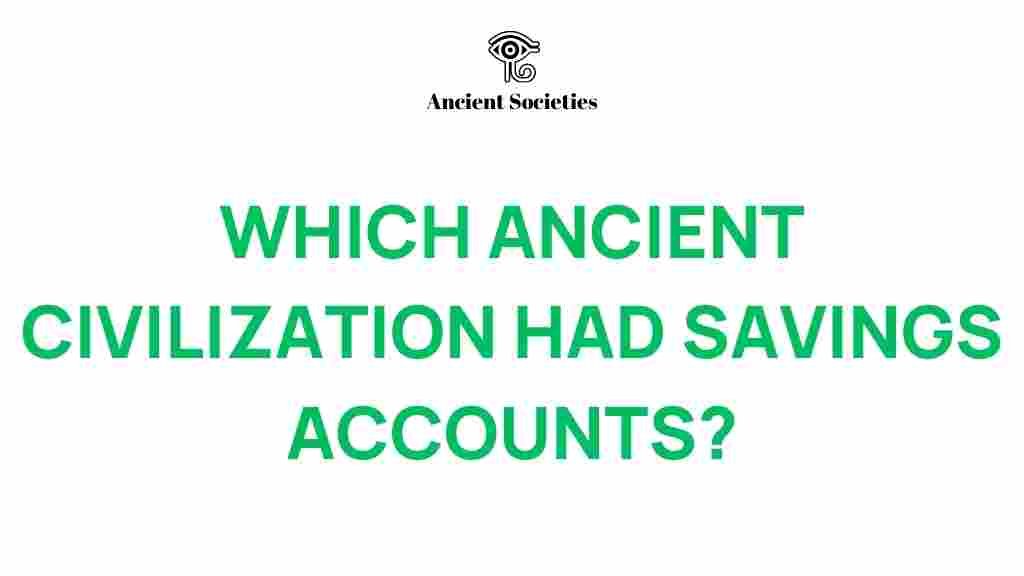Unearthing the Secrets of Ancient Savings Accounts
Throughout history, the concept of savings and banking has played a crucial role in the development of economies and civilizations. From the bustling trade routes of ancient Mesopotamia to the sophisticated financial systems of later cultures, understanding the origins of ancient savings accounts reveals much about human society’s growth and adaptability.
The Birth of Banking in Mesopotamia
Mesopotamia, often referred to as the “cradle of civilization,” is where we first see the rudiments of banking emerge. Between the Tigris and Euphrates rivers, the Sumerians developed one of the earliest known forms of writing, cuneiform, which was crucial for keeping financial records.
- Trade Expansion: As trade expanded, so did the need for secure storage of wealth.
- Grain as Currency: Sumerians stored surplus grain, which acted as both food reserves and a form of currency.
- Temple Banks: Temples served as early banking institutions where citizens deposited their grain and valuables.
How Ancient Savings Accounts Functioned
The concept of ancient savings accounts revolved around the safekeeping of assets, primarily grain and precious metals. Here’s a step-by-step look at how these accounts worked:
- Depositing Assets: Individuals would bring their surplus goods—such as grains or silver—to temples or designated banking establishments.
- Record Keeping: Bankers recorded the deposits on clay tablets, ensuring that every transaction was documented.
- Interest Accrual: Depositors could earn interest on their stored goods, encouraging savings.
- Withdrawal Procedures: When needed, individuals could withdraw their assets, subject to the terms set by the banking institution.
Economic Impact of Ancient Banking Systems
These early banking systems had far-reaching impacts on the economy of ancient civilizations:
- Facilitated Trade: With a secure place to store wealth, merchants could travel and trade without the fear of losing their assets.
- Encouraged Investment: Surplus goods could be lent to farmers to help them grow more crops, thereby boosting overall productivity.
- Stabilized Economies: By providing a reliable means of saving and borrowing, these systems contributed to economic stability.
Archaeological Evidence of Ancient Savings Accounts
Archaeology has uncovered a wealth of information regarding the early practices of banking and finance in ancient civilizations. Significant findings include:
- Clay Tablets: Thousands of clay tablets have been unearthed, detailing various transactions and contracts.
- Temple Ruins: Excavations of temple complexes show how integral these institutions were to the economy.
- Artifacts: Items such as seals and weights used in transactions provide insight into the financial practices of the time.
Challenges and Troubleshooting in Ancient Banking
Like any financial system, ancient banking faced challenges. Here are some common issues and their solutions:
- Theft: Temples and banks were sometimes targets of theft. Security measures included:
- Building strong, fortified structures.
- Employing guards to protect assets.
- Disputes over Transactions: Conflicts could arise concerning deposits and withdrawals. Solutions included:
- Maintaining clear records on clay tablets.
- Using witnesses to verify transactions.
- Interest Rates: High-interest rates could deter savings. Some banks adjusted rates to encourage deposits.
Comparing Ancient Civilizations’ Banking Practices
Although Mesopotamia laid the groundwork for banking, other ancient civilizations also developed their own financial systems:
- Egypt: The Egyptians used grain banks, which were essential for managing the economy, especially during the annual flooding of the Nile.
- Greece: The Greeks developed more advanced banking practices, including loans and interest-bearing deposits, setting the stage for modern banking.
- Rome: Roman banking included sophisticated practices such as public loans and the use of promissory notes.
The Legacy of Ancient Savings Accounts
The innovations in banking and finance from ancient civilizations have shaped modern financial systems. The basic principles of savings accounts, loans, and interest are still prevalent today. The transition from ancient savings accounts to contemporary banking illustrates how economic practices evolve while retaining core concepts.
Conclusion: The Importance of Understanding Ancient Banking
Exploring the history of ancient savings accounts offers valuable insights into how civilizations managed their economies and facilitated trade. From the early practices in Mesopotamia to the more developed systems in Greece and Rome, the evolution of banking has been pivotal in shaping our modern financial landscape. Understanding these foundational systems not only honors our past but also informs future economic strategies.
To learn more about the history of finance and banking, check out this comprehensive resource.
As we continue to study and appreciate the intricacies of ancient economies, it becomes clear that the roots of our current financial practices lie deeply embedded in the history of human civilization.
For further reading on related topics, please visit our finance and economy section.
This article is in the category Archaeology and created by AncientSocieties Team
